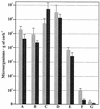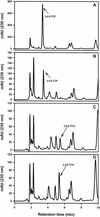Cork taint of wines: role of the filamentous fungi isolated from cork in the formation of 2,4,6-trichloroanisole by o methylation of 2,4,6-trichlorophenol
- PMID: 12450804
- PMCID: PMC134401
- DOI: 10.1128/AEM.68.12.5860-5869.2002
Cork taint of wines: role of the filamentous fungi isolated from cork in the formation of 2,4,6-trichloroanisole by o methylation of 2,4,6-trichlorophenol
Abstract
Cork taint is a musty or moldy off-odor in wine mainly caused by 2,4,6-trichloroanisole (2,4,6-TCA). We examined the role of 14 fungal strains isolated from cork samples in the production of 2,4,6-TCA by O methylation of 2,4,6-trichlorophenol (2,4,6-TCP). The fungal strains isolated belong to the genera Penicillium (four isolates); Trichoderma (two isolates); and Acremonium, Chrysonilia, Cladosporium, Fusarium, Mortierella, Mucor, Paecilomyces, and Verticillium (one isolate each). Eleven of these strains could produce 2,4,6-TCA when they were grown directly on cork in the presence of 2,4,6-TCP. The highest levels of bioconversion were carried out by the Trichoderma and Fusarium strains. One strain of Trichoderma longibrachiatum could also efficiently produce 2,4,6-TCA in liquid medium. However, no detectable levels of 2,4,6-TCA production by this strain could be detected on cork when putative precursors other than 2,4,6-TCP, including several anisoles, dichlorophenols, trichlorophenols, or other highly chlorinated compounds, were tested. Time course expression studies with liquid cultures showed that the formation of 2,4,6-TCA was not affected by a high concentration of glucose (2% or 111 mM) or by ammonium salts at concentrations up to 60 mM. In T. longibrachiatum the O methylation of 2,4,6-TCP was catalyzed by a mycelium-associated S-adenosyl-L-methionine (SAM)-dependent methyltransferase that was strongly induced by 2,4,6-TCP. The reaction was inhibited by S-adenosyl-L-homocysteine, an inhibitor of SAM-dependent methylation, suggesting that SAM is the natural methyl donor. These findings increase our understanding of the mechanism underlying the origin of 2,4,6-TCA on cork, which is poorly understood despite its great economic importance for the wine industry, and they could also help us improve our knowledge about the biodegradation and detoxification processes associated with chlorinated phenols.
Figures




References
-
- Amon, J. M., J. M. Vandepeer, and R. F. Simpson. 1989. Compounds responsible for cork taint in wine. Wine Ind. J. 4:62-69.
-
- Bradford, M. M. 1976. A rapid and sensitive method for quantitation of microgram quantities of protein utilizing the principle of protein-dye binding. Anal. Biochem. 72:248-254. - PubMed
-
- Butzke, C. E., T. J. Evans, and S. E. Ebeler. 1999. Detection of cork taint in wine using automated solid-phase microextraction in combination with GC/MS-SIM. ACS Symp. Ser. 714:208-216.
Publication types
MeSH terms
Substances
LinkOut - more resources
Full Text Sources
Medical
Molecular Biology Databases

